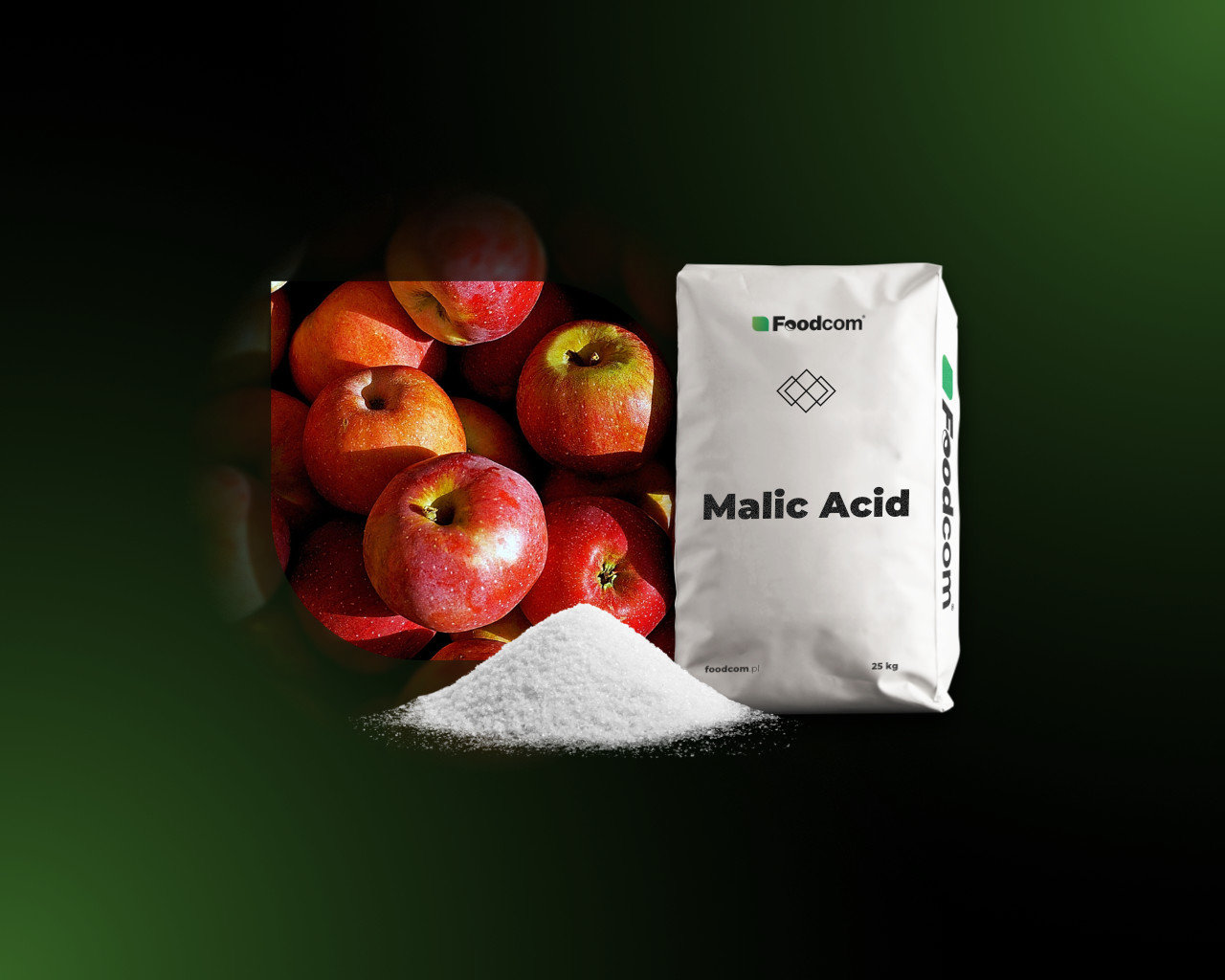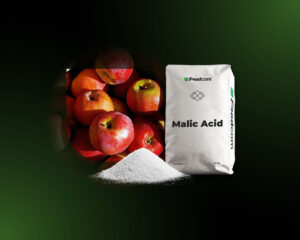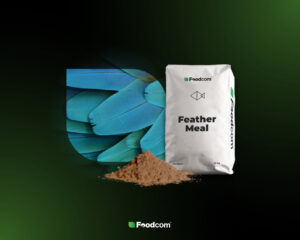- Kwas Jabłkowy to organiczny związek chemiczny, naturalnie występujący w niektórych owocach i warzywach.
- Jest wykorzystywany jako środek konserwujący, stabilizujący kolor i wzmacniający smak.
- Kwas Jabłkowy jest stosowany w produkcji przetworów owocowych, napojów gazowanych, dżemów, gum do żucia, cukierków, dressingów i sosów.
- Korzysta się z niego również w przemyśle winiarskim, paszowym, kosmetycznym, farmaceutycznym i chemicznym.
Co to jest Kwas Jabłkowy?
Kwas Jabłkowy to organiczny związek chemiczny, który należy do grupy kwasów dikarboksylowych. Jest naturalnie występującym kwasem obecnym w niedojrzałych owocach i warzywach, takich jak między innymi jabłka, winogrona, jagody, cytryny, pomarańcze, brokuły, pomidory i rabarbar. Nazwa – Malic Acid – pochodzi od łacińskiego malum, oznaczającego jabłko, ze względu na jego naturalne pochodzenie.
Dzięki swoim właściwościom Kwas Jabłkowy może być używany jako środek konserwujący, regulujący kwasowość, stabilizujący kolor i wzmacniający smak. Jest dodatkiem do żywności znanym jako E296. Gdzie wykorzystuje się Kwas Jabłkowy? Czytaj dalej, by się dowiedzieć!
Produkcja Kwasu Jabłkowego
Ekstrakcja kwasu jabłkowego z naturalnych roślin jest kosztowna, dlatego komercyjne produkty są zwykle otrzymywane przez chemiczną hydratację kwasu maleinowego lub kwasu fumarowego przy użyciu wysokich temperatur i wysokiego ciśnienia. Końcowy produkt ma postać białych, krystalicznych granulek. Kwas jabłkowy ma gładki, cierpki lub kwaśny smak i nie posiada obcych zapachów. Jest bardzo rozpuszczalny w wodzie, ale ma niższą higroskopijność niż kwas cytrynowy. Kwas jabłkowy charakteryzuje się wysoką szybkością degradacji przez mikroorganizmy, takie jak drożdże.
Kwas Jabłkowy właściwości
Kwas Jabłkowy występuje w postaci białych, krystalicznych granulek. Ma łagodny, cierpki lub kwaśny smak i jest praktycznie bezwonny. Jest wysoce rozpuszczalny w wodzie, ale ma niższy wskaźnik higroskopijności niż Kwas Cytrynowy. W branży spożywczej jest stosowany jako jeden z najskuteczniejszych substytutów Kwasu Cytrynowego. Kwas Jabłkowy ma wysoki stopień degradacji przez mikroorganizmy, takie jak drożdże.
Ten związek posiada wiele wartościowych właściwości oraz działań, takich jak: hamowanie wzrostu bakterii, czyli działanie konserwacyjne, złuszczanie, rozjaśnianie oraz regulacja kwasowości innych substancji.
Kwas Jabłkowy a ocet jabłkowy
Kwas Jabłkowy jest często mylony z octem jabłkowym, ale nie są to te same substancje. Kwas Jabłkowy to organiczny związek chemiczny zawarty w owocach i warzywach, zaś ocet jabłkowy uzyskiwany jest jako produkt naturalnej fermentacji surowców roślinnych. Łączy je to, że kwas jabłkowy wchodzi w skład octu jabłkowego.
Kwas Jabłkowy – zastosowanie
W przemyśle spożywczym i napojów Kwas Jabłkowy jest szeroko stosowany jako środek konserwujący E296. Jest również powszechnie wykorzystywany jako wzmacniacz słodyczy lub cierpkości w sokach owocowych i warzywnych, mrożonej herbacie w proszku, napojach gazowanych, dżemach, gumach do żucia i cukierkach. Przedłuża uwalnianie się smaków owocowych i tworzy wrażenie mocniejszego aromatu. Poza tym produkt wzmacnia i zachowuje smak dressingów, sosów i majonezów poprzez zapobieganie jełczeniu tłuszczów. W przemyśle winiarskim Kwas Jabłkowy jest wykorzystywany jako podstawa fermentacji malolaktycznej, pozwalając producentom na wytwarzanie win o łagodniejszym smaku.
Kwas Jabłkowy znajduje również zastosowanie jako składnik w żywieniu zwierząt. W przypadku trzody chlewnej produkt ten wykazuje pozytywny wpływ na przyrosty masy ciała prosiąt, zmniejszenie śmiertelności oraz rzadsze występowanie biegunek. W diecie bydła i owiec suplementacja Kwasem Jabłkowym odpowiada za wspomaganie wzrostu, zwiększenie produkcji mleka, poprawę ogólnej wydajności oraz poprawę efektywności wykorzystania paszy.
W sektorze kosmetycznym Kwas Jabłkowy jest stosowany ze względu na swoje właściwości kontrolowania pH w kremach samoopalających, mydłach, produktach przeciwtrądzikowych i kremach przeciwstarzeniowych. Przy niskich stężeniach (do 5%) działa nawilżająco i rozjaśniająco, podczas gdy w wyższych stężeniach delikatnie złuszcza i zmiękcza zgrubiałą warstwę skóry. Jego właściwości złuszczające znajdują zastosowanie w żelach oczyszczających i peelingach do twarzy. Kwas Jabłkowy jest również stosowany w płukankach do ust i pastach do zębów, ponieważ zmniejsza smak innych substancji chemicznych.
W sektorze farmaceutycznym produkt ten jest stosowany w leczeniu suchości w ustach, przewlekłego zmęczenia i fibromialgii. Ponadto jest składnikiem syropów i tabletek.
Kwas Jabłkowy znajduje swoje zastosowanie także w przemyśle chemicznym. Jest wykorzystywany w syntezach chemicznych, w celu uzyskania innych związków. Z kolei jabłczan, czyli zjonizowana forma Kwasu Jabłkowego, jest produktem pośrednim w cyklu Krebsa.
Dlaczego Foodcom?
Nasz zespół Wsparcia Sprzedaży pomaga naszym Partnerom Handlowym w sprawnym i efektywnym przeprowadzeniu transakcji handlowych, aby zapewnić najwyższą jakość usług dla wszystkich naszych Partnerów Handlowych. Nasz zespół logistyczny zadba o transport, a dział finansowy będzie odpowiedzialny za wszystkie sprawy związane z finansową częścią transakcji.







